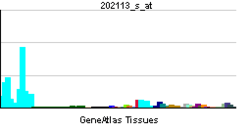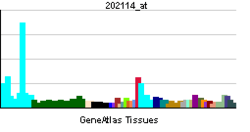SNX2
| View/Edit Human | View/Edit Mouse |
Sorting nexin-2 is a protein that in humans is encoded by the SNX2 gene.[3][4]
Function
This gene encodes a member of the sorting nexin family. Members of this family contain a phox (PX) domain, which is a phosphoinositide binding domain, and are involved in intracellular trafficking. This protein associates with formin-binding protein 17, but its function is unknown. This protein may form oligomeric complexes with family members.[4]
Interactions
SNX2 has been shown to interact with FNBP1.[5][6]
References
- ↑ "Human PubMed Reference:".
- ↑ "Mouse PubMed Reference:".
- ↑ Haft CR, de la Luz Sierra M, Barr VA, Haft DH, Taylor SI (Dec 1998). "Identification of a family of sorting nexin molecules and characterization of their association with receptors". Molecular and Cellular Biology. 18 (12): 7278–87. doi:10.1128/mcb.18.12.7278. PMC 109309
 . PMID 9819414.
. PMID 9819414. - 1 2 "Entrez Gene: SNX2 sorting nexin 2".
- ↑ Fuchs U, Rehkamp GF, Slany R, Follo M, Borkhardt A (Nov 2003). "The formin-binding protein 17, FBP17, binds via a TNKS binding motif to tankyrase, a protein involved in telomere maintenance". FEBS Letters. 554 (1-2): 10–6. doi:10.1016/S0014-5793(03)01063-9. PMID 14596906.
- ↑ Fuchs U, Rehkamp G, Haas OA, Slany R, Kōnig M, Bojesen S, Bohle RM, Damm-Welk C, Ludwig WD, Harbott J, Borkhardt A (Jul 2001). "The human formin-binding protein 17 (FBP17) interacts with sorting nexin, SNX2, and is an MLL-fusion partner in acute myelogeneous leukemia". Proceedings of the National Academy of Sciences of the United States of America. 98 (15): 8756–61. doi:10.1073/pnas.121433898. PMC 37508
 . PMID 11438682.
. PMID 11438682.
Further reading
- Maruyama K, Sugano S (Jan 1994). "Oligo-capping: a simple method to replace the cap structure of eukaryotic mRNAs with oligoribonucleotides". Gene. 138 (1-2): 171–4. doi:10.1016/0378-1119(94)90802-8. PMID 8125298.
- Suzuki Y, Yoshitomo-Nakagawa K, Maruyama K, Suyama A, Sugano S (Oct 1997). "Construction and characterization of a full length-enriched and a 5'-end-enriched cDNA library". Gene. 200 (1-2): 149–56. doi:10.1016/S0378-1119(97)00411-3. PMID 9373149.
- Haft CR, de la Luz Sierra M, Bafford R, Lesniak MA, Barr VA, Taylor SI (Dec 2000). "Human orthologs of yeast vacuolar protein sorting proteins Vps26, 29, and 35: assembly into multimeric complexes". Molecular Biology of the Cell. 11 (12): 4105–16. doi:10.1091/mbc.11.12.4105. PMC 15060
 . PMID 11102511.
. PMID 11102511. - Parks WT, Frank DB, Huff C, Renfrew Haft C, Martin J, Meng X, de Caestecker MP, McNally JG, Reddi A, Taylor SI, Roberts AB, Wang T, Lechleider RJ (Jun 2001). "Sorting nexin 6, a novel SNX, interacts with the transforming growth factor-beta family of receptor serine-threonine kinases". The Journal of Biological Chemistry. 276 (22): 19332–9. doi:10.1074/jbc.M100606200. PMID 11279102.
- Fuchs U, Rehkamp G, Haas OA, Slany R, Kōnig M, Bojesen S, Bohle RM, Damm-Welk C, Ludwig WD, Harbott J, Borkhardt A (Jul 2001). "The human formin-binding protein 17 (FBP17) interacts with sorting nexin, SNX2, and is an MLL-fusion partner in acute myelogeneous leukemia". Proceedings of the National Academy of Sciences of the United States of America. 98 (15): 8756–61. doi:10.1073/pnas.121433898. PMC 37508
 . PMID 11438682.
. PMID 11438682. - Teasdale RD, Loci D, Houghton F, Karlsson L, Gleeson PA (Aug 2001). "A large family of endosome-localized proteins related to sorting nexin 1". The Biochemical Journal. 358 (Pt 1): 7–16. doi:10.1042/0264-6021:3580007. PMC 1222026
 . PMID 11485546.
. PMID 11485546. - Fuchs U, Rehkamp GF, Slany R, Follo M, Borkhardt A (Nov 2003). "The formin-binding protein 17, FBP17, binds via a TNKS binding motif to tankyrase, a protein involved in telomere maintenance". FEBS Letters. 554 (1-2): 10–6. doi:10.1016/S0014-5793(03)01063-9. PMID 14596906.
- Gullapalli A, Garrett TA, Paing MM, Griffin CT, Yang Y, Trejo J (May 2004). "A role for sorting nexin 2 in epidermal growth factor receptor down-regulation: evidence for distinct functions of sorting nexin 1 and 2 in protein trafficking". Molecular Biology of the Cell. 15 (5): 2143–55. doi:10.1091/mbc.E03-09-0711. PMC 404011
 . PMID 14978220.
. PMID 14978220. - Beausoleil SA, Jedrychowski M, Schwartz D, Elias JE, Villén J, Li J, Cohn MA, Cantley LC, Gygi SP (Aug 2004). "Large-scale characterization of HeLa cell nuclear phosphoproteins". Proceedings of the National Academy of Sciences of the United States of America. 101 (33): 12130–5. doi:10.1073/pnas.0404720101. PMC 514446
 . PMID 15302935.
. PMID 15302935. - Schaaf CP, Benzing J, Schmitt T, Erz DH, Tewes M, Bartram CR, Janssen JW (Feb 2005). "Novel interaction partners of the TPR/MET tyrosine kinase". FASEB Journal. 19 (2): 267–9. doi:10.1096/fj.04-1558fje. PMID 15546961.
- Abdul-Ghani M, Hartman KL, Ngsee JK (Jul 2005). "Abstrakt interacts with and regulates the expression of sorting nexin-2". Journal of Cellular Physiology. 204 (1): 210–8. doi:10.1002/jcp.20285. PMC 2963638
 . PMID 15690390.
. PMID 15690390. - Carlton JG, Bujny MV, Peter BJ, Oorschot VM, Rutherford A, Arkell RS, Klumperman J, McMahon HT, Cullen PJ (Oct 2005). "Sorting nexin-2 is associated with tubular elements of the early endosome, but is not essential for retromer-mediated endosome-to-TGN transport". Journal of Cell Science. 118 (Pt 19): 4527–39. doi:10.1242/jcs.02568. PMC 1904489
 . PMID 16179610.
. PMID 16179610. - Beausoleil SA, Villén J, Gerber SA, Rush J, Gygi SP (Oct 2006). "A probability-based approach for high-throughput protein phosphorylation analysis and site localization". Nature Biotechnology. 24 (10): 1285–92. doi:10.1038/nbt1240. PMID 16964243.
- Rojas R, Kametaka S, Haft CR, Bonifacino JS (Feb 2007). "Interchangeable but essential functions of SNX1 and SNX2 in the association of retromer with endosomes and the trafficking of mannose 6-phosphate receptors". Molecular and Cellular Biology. 27 (3): 1112–24. doi:10.1128/MCB.00156-06. PMC 1800681
 . PMID 17101778.
. PMID 17101778. - Skånland SS, Wälchli S, Utskarpen A, Wandinger-Ness A, Sandvig K (Mar 2007). "Phosphoinositide-regulated retrograde transport of ricin: crosstalk between hVps34 and sorting nexins". Traffic. 8 (3): 297–309. doi:10.1111/j.1600-0854.2006.00527.x. PMID 17319803.
This article is issued from Wikipedia - version of the 5/20/2016. The text is available under the Creative Commons Attribution/Share Alike but additional terms may apply for the media files.

